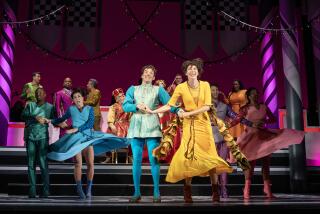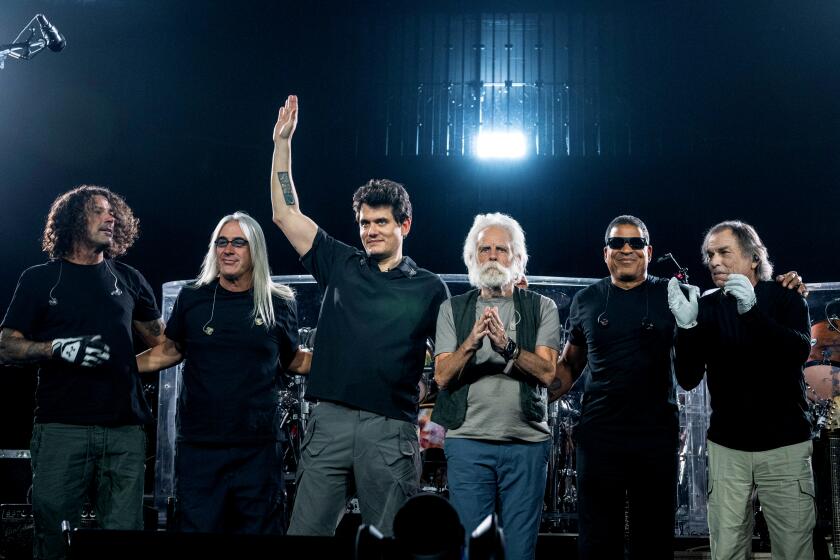Guitarist Leo Kottke Still Trying Some New Things : The musician’s compositions resonate with a strong sense of place. He will perform tonight in San Juan Capistrano.
Let others have the riches and fame. Leo Kottke is content with the respect of his peers and the somewhat more arcane satisfactions that have resulted from the guitarist’s 20-year career as an American original.
“I’ve won those guitar readers poll things, and those are all nice,” Kottke, who plays the Coach House in San Juan Capistrano tonight, said last week by phone from his home near Minneapolis. “But the stuff that really sticks with me is when Joe Pass came backstage to a show I did in Australia and said, ‘Boy, you got some nice little things there.’ That’s the stuff that’s rewarding. That and there’s some chicken feet.”
Pardon us, Leo, but it sounded like you just said chicken feet .
“So far nothing really chicken feet, but every now and then, from somebody somewhere--it happens in different parts of the country--I see a pair of chicken feet flying through the air. They’re usually made out of some kind of stuffed fabric. I’ve got three pairs in 20 years, once here in Minnesota, once in California, and once it was Iowa.
“Those are things that wouldn’t happen if I was doing something different. I don’t think if you teach high school or work at a bank that you see chicken feet flying through the air. It’s a great job.”
Kottke has no idea why people choose, albeit rarely, to toss chicken feet during his performances. He has, however, flung some pretty strange stuff out there himself. Since 1970, on albums with titles like “My Feet Are Smiling” and “Burnt Lips,” he has exercised a prodigious, award-winning technique and has displayed a rare humor on his sonorous 12-string acoustic guitar. Like those of his mentor, John Fahey, Kottke’s compositions resonate with a strong sense of place, whether that place be a river bank or a cretinous auto shop.
Kottke has a new album, to be called “That’s What,” due out in a couple of months, and he’s a bit worried about it.
“My wife hates it. My manager hates it. The record company likes it, which is a reversal of my usual experience, and therefore a little terrifying.
“I like it a lot . It’s got more going for it than I usually manage to get on a tape. I think I’ve learned how to make the right kind of mistakes instead of the ones that happen because you’re trying not to make any. In other words, if you do a lot of takes on a tune, you may eventually get it right, but it takes so long, and what you find out later is you got it right, but all the music went away. I’m finding if you keep your first or second take and there’s something in it you can’t stand, in a couple of months you can’t remember what bothered you about it.
“Plus, I’m beginning to notice that mistakes have their own kind of charm. There’s really nothing wrong with them. They reveal a lot. Like this last record I know of Chet Baker making, he’s singing and you get to hear the lack of teeth in his head, on those s’s, those big lateral sort of lisps. I don’t know, maybe it drove him nuts, but it fits the music just fine.”
Along with allowing those humanizing flaws, “That’s What” will include some other departures from Kottke’s past efforts. “The most obvious thing is there’s two tunes with as many as six trombones on them. That was something I had to do sooner or later because I used to play trombone, and I wanted to hear some choral ‘bone.’ ”
The album will be the first time he performs on his new fretted love, the six-string electric bass. He found the instrument, a Jerry Jones replica of a ‘60s budget Danelectro, at January’s National Assn. of Music Merchandisers show in Anaheim. He said it was love at first sight.
“That thing is like getting off your tricycle and jumping into a pickup truck. It’s another world. I’ve been trying to get this sound for years on my own, using huge strings and tuning my guitars down, and nothing ever worked. I play the bass on about three cuts on the record, and I’m sure there’s more of that to come. That happens to be what my manager hates about it. He calls the record ‘a shout toward Stanley Clarke,’ ” Kottke laughed.
Since he performs solo, Kottke has yet to try the trombones out on an audience, but he said his listeners always have been supportive of the changes in his music. Although he tries to have a meaningful effect on his audiences, he’s careful not to examine the process too carefully.
“I’ve always thought that it was dangerous to even think about that part of things. Something does happen, but I think it tends to go away if I look at it. I heard a story about (classical pianist) Glenn Gould. He was asked how he managed that remarkable technique. And Gould said it was a centipedal question and wouldn’t answer it, instead telling this story about a spider who wanted to eat a centipede, and never could catch it. One day the centipede walked by and the spider said, ‘How do you manage to walk when you’ve got all those legs, moving at the right time?’ The centipede said, ‘I don’t know,’ and couldn’t move for trying to figure it out, and of course at that point the spider jumped on him.
“So the fact is, I never think about it. I try to genuinely enjoy what I’m doing when I play for people. If I do, that enjoyment seems to be shared.”
What he looks for in the music of others, he said, is “motion, either harmonic or rhythmically, or preferably both, and some kind of narrative sense about the thing. I can hear that in all kinds of stuff; the style doesn’t seem to matter. And I enjoy a sense of humor. Joe Pass just plays that way all the time. You know that there’s never a heavy hand in there, that even when the lights are going out, mood-wise, you know that it’s just an inch away from daylight.”
When Kottke met the jazz great in Australia recently, they played together and, Kottke said: “It made my skin crawl. He is really, really something. He kept claiming that he was intellectually tired, that he wasn’t feeling a lot like playing these days, but there were four of us down there including John Williams and Paco Pena, and the only guy who never stopped playing was Joe. Every time you turned around there he was playing. I was knocked out.”
Kottke said he is seriously undertaking the study of his instrument for the first time in his 30 years of playing, working on harmony voicings and fretboard technique. At the same time he’s expanding his technique, he believes that his music relies on it less, as he goes more for mood and feeling.
“I don’t go for just hitting it over the head like I used to. I used to try to just blow my stack every time I wrote something. That was what I looked for, the thrills and the certain kind of velocity or rhythm. And now I’m more curious about what’s going on.
“That’s a little dangerous at first, I think, because in the beginning you just try to slow down and get a look at the scenery that goes by. But later on you learn how to harmonize some scales and get some other kind of motion in there, things that aren’t as obvious and I think hold up better.”
In addition to “That’s What,” Kottke provided the musical backing for a children’s album due shortly on a Windham Hill record that has Jonathan Winters narrating the story of Paul Bunyan. He also has been composing music for guitar and orchestra with Steve Paulus, composer in residence with the Atlanta Symphony.
“We’re starting with a traditional form called an English suite, and hoping that it will work,” Kottke said. “We both want to write something that won’t stand on its own either as a guitar solo or something for orchestra. There’s a lot of pops kind of approaches that use orchestras just as a wash back there, and we’re trying to come up with something that actually lets them play. That’s exciting, but it’s also kind of terrifying. We have to write it because it’s already booked.”
The piece will debut in September in Grand Junction, Colo., with performances following in Ft. Wayne, Ind., somewhere in New Jersey and in Denver before it plays Atlanta. And somewhere out there, fans are probably already sewing tuxedo legs on their chicken feet.
Leo Kottke plays tonight at 8 at the Coach House, 33157 Camino Capistrano, San Juan Capistrano. Tickets: $18.50. Information: (714) 496-8930.
More to Read
The biggest entertainment stories
Get our big stories about Hollywood, film, television, music, arts, culture and more right in your inbox as soon as they publish.
You may occasionally receive promotional content from the Los Angeles Times.










